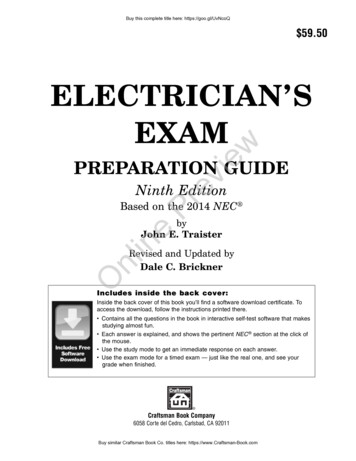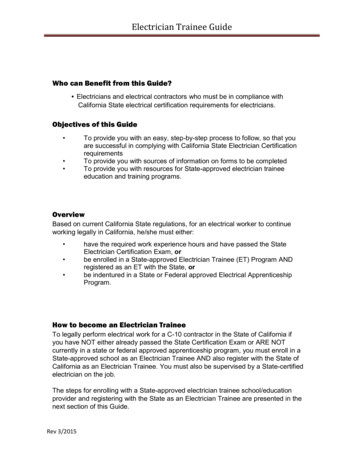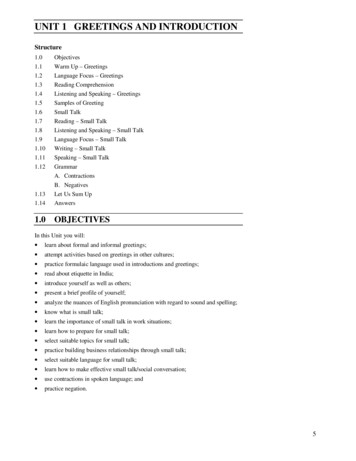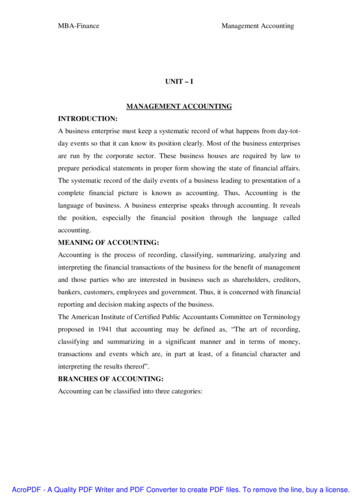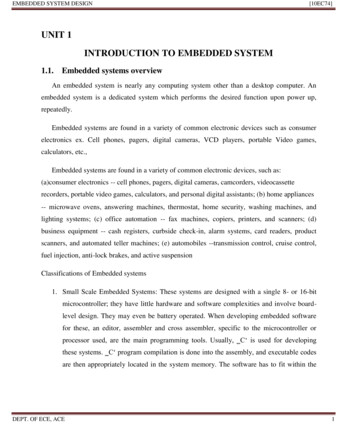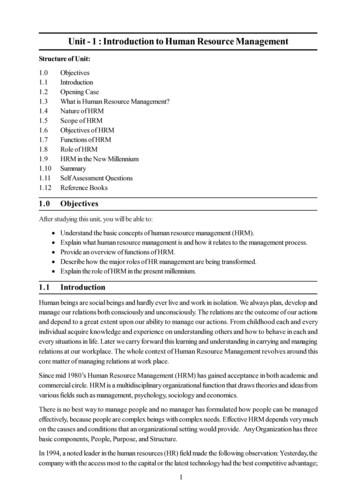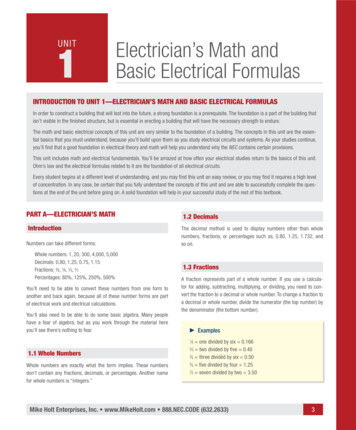
Transcription
UNIT1Electrician’s Math andBasic Electrical FormulasINTRODUCTION TO UNIT 1—ELECTRICIAN’S MATH AND BASIC ELECTRICAL FORMULASIn order to construct a building that will last into the future, a strong foundation is a prerequisite. The foundation is a part of the building thatisn’t visible in the finished structure, but is essential in erecting a building that will have the necessary strength to endure.The math and basic electrical concepts of this unit are very similar to the foundation of a building. The concepts in this unit are the essential basics that you must understand, because you’ll build upon them as you study electrical circuits and systems. As your studies continue,you’ll find that a good foundation in electrical theory and math will help you understand why the NEC contains certain provisions.This unit includes math and electrical fundamentals. You’ll be amazed at how often your electrical studies return to the basics of this unit.Ohm’s law and the electrical formulas related to it are the foundation of all electrical circuits.Every student begins at a different level of understanding, and you may find this unit an easy review, or you may find it requires a high levelof concentration. In any case, be certain that you fully understand the concepts of this unit and are able to successfully complete the questions at the end of the unit before going on. A solid foundation will help in your successful study of the rest of this textbook.PART A—ELECTRICIAN’S MATH1.2 DecimalsIntroductionThe decimal method is used to display numbers other than wholenumbers, fractions, or percentages such as, 0.80, 1.25, 1.732, andso on.Numbers can take different forms:Whole numbers: 1, 20, 300, 4,000, 5,000Decimals: 0.80, 1.25, 0.75, 1.15Fractions: 1/2, 1/4, 5 8, 4 3Percentages: 80%, 125%, 250%, 500%You’ll need to be able to convert these numbers from one form toanother and back again, because all of these number forms are partof electrical work and electrical calculations.You’ll also need to be able to do some basic algebra. Many peoplehave a fear of algebra, but as you work through the material hereyou’ll see there’s nothing to fear.1.3 FractionsA fraction represents part of a whole number. If you use a calculator for adding, subtracting, multiplying, or dividing, you need to convert the fraction to a decimal or whole number. To change a fraction toa decimal or whole number, divide the numerator (the top number) bythe denominator (the bottom number).c Examples 6 one divided by six 0.166 5 two divided by five 0.403 6 three divided by six 0.505 4 five divided by four 1.257 2 seven divided by two 3.5011.1 Whole NumbersWhole numbers are exactly what the term implies. These numbersdon’t contain any fractions, decimals, or percentages. Another namefor whole numbers is “integers.”2Mike Holt Enterprises, Inc. www.MikeHolt.com 888.NEC.CODE (632.2633)3
Electrician’s Math and Basic Electrical FormulasUnit 11.4 Percentagesc Example 1A percentage is another method used to display a value. One hundredpercent (100%) means all of a value; fifty percent (50%) means onehalf of a value, and twenty-five percent (25%) means one-fourth of avalue.Question: An overcurrent device (circuit breaker or fuse) mustbe sized no less than 125 percent of the continuous load. Ifthe load is 80A, the overcurrent device will have to be sized nosmaller than . Figure 1–2For convenience in multiplying or dividing by a percentage, convertthe percentage value to a whole number or decimal, and then use theresult for the calculation. When changing a percent value to a decimalor whole number, drop the percentage symbol and move the decimalpoint two places to the left. Figure 1–1(a) 75A(b) 80A(c) 100A(d) 125AAnswer: (c) 100AStep 1: Convert 125 percent to a decimal: 1.25Step 2: Multiply the value of the 80A load by 1.25 100AFigure 1–1Figure 1–2c 1.252.50c Example 2Question: The maximum continuous load on an overcurrentdevice is limited to 80 percent of the device rating. If the overcurrent device is rated 50A, what’s the maximum continuousload permitted on the overcurrent device? Figure 1–3(a) 40A1.5 MultiplierWhen a number needs to be changed by multiplying it by a percentage, the percentage is called a multiplier. The first step is to convertthe percentage to a decimal, then multiply the original number by thedecimal value.4(b) 50A(c) 75A(d) 100AAnswer: (a) 40AStep 1: Convert 80 percent to a decimal: 0.80Step 2: Multiply the value of the 50A device rating by 0.80 40AMike Holt’s Illustrated Guide to Electrical Exam Preparation 2011 Edition
Electrician’s Math and Basic Electrical FormulasUnit 1c Example 2Question: If the feeder demand load for a range is 8 kW and it’srequired to be increased by 15 percent, the total calculated loadwill be . Figure 1–4(a) 6.80 kW(b) 8 kW(c) 9.20 kW(d) 15 kWAnswer: (c) 9.20 kWStep 1: Convert the percentage increase required to decimalform: 15 percent 0.15Step 2: Add one to the decimal: 1 0.15 1.15Step 3: Multiply 8 by the multiplier 1.15: 8 kW x 1.15 9.20 kWFigure 1–31.6 Percent IncreaseUse the following steps to increase a number by a specific percentage:Step 1: Convert the percent to a decimal value.Step 2: Add one to the decimal value to create the multiplier.Step 3: Multiply the original number by the multiplier found in Step2.c Example 1Question: How do you increase the whole number 45 by 35percent?Step 1: Convert 35 percent to decimal form: 0.35Figure 1–4Step 2: Add one to the decimal value: 1 0.35 1.35Step 3: Multiply 45 by the multiplier 1.35: 45 x 1.35 60.751.7 ReciprocalsTo obtain the reciprocal of a number, convert the number into a fraction with the number one as the numerator (the top number). It’s alsopossible to calculate the reciprocal of a decimal number. Determinethe reciprocal of a decimal number by following these steps:Step 1: Convert the number to a decimal value.Step 2: Divide the value into the number one.Mike Holt Enterprises, Inc. www.MikeHolt.com 888.NEC.CODE (632.2633)5
Electrician’s Math and Basic Electrical FormulasUnit 1c Example 1c Example 2Question: What’s the reciprocal of 80 percent?Question: What’s the area in square inches (sq in.) of a tradesize 1 raceway with an inside diameter of 1.049 in.?(a) 0.80(b) 100%(c) 125%(d) 150%Answer: (c) 125%Step 1: Convert 80 percent into a decimal (move the decimaltwo places to the left): 80 percent 0.80Step 2: Divide 0.80 into the number one:1/0.80 1.25 or 125 percentQuestion: What’s the reciprocal of 125 percent?(b) 0.80(c) 100%(a) 0.34 sq in.(b) 0.50 sq in.(c) 0.86 sq in. (d) 1 sq in.Answer: (c) 0.86 sq in.c Example 2(a) 75%Formula: Area π x r2π 3.14r radius (equal to 0.50 of the diameter)(d) 125%Area π x r2Area 3.14 x (0.50 x 1.049)2Area 3.14 x 0.52452Area 3.14 x (0.5245 x 0.5245)Area 3.14 x 0.2751Area 0.86 sq in.Answer: (b) 0.80c Example 3Step 1: Convert 125 percent into a decimal:125 percent 1.25Question: What’s the sq in. area of an 8 in. pizza? Figure 1–5AStep 2: Divide 1.25 into the number one:1/1.25 0.80 or 80 percent(a) 25 sq in.(b) 50 sq in.(c) 64 sq in.(d) 75 sq in.Answer: (b) 50 sq in.1.8 Squaring a NumberSquaring a number means multiplying the number by itself.102 10 x 10 100or232 23 x 23 529c Example 1Area π x r2Area 3.14 x (0.50 x 8)2Area 3.14 x 42Area 3.14 x (4 x 4)Area 3.14 x 16Area 50 sq in.Question: What’s the power consumed in watts by a 12 AWGconductor that’s 200 ft long, and has a total resistance of 0.40ohms, if the current (I) in the circuit conductors is 16A? (Answersare rounded to the nearest 50).Formula: Power I 2 x R(a) 50W(b) 100W(c) 150W(d) 200WAnswer: (b) 100WP I2 x RI 16AR 0.40 ohmsP 16A2 x 0.40 ohmsP 16A x 16A x 0.40 ohmsP 102.40W6Figure 1–5Mike Holt’s Illustrated Guide to Electrical Exam Preparation 2011 Edition
Electrician’s Math and Basic Electrical FormulasUnit 1c Example 4Question: What’s the sq in. area of a 16 in. pizza? Figure 1–5B(a) 100 sq in.(b) 150 sq in.(c) 200 sq in. (d) 256 sq in.Answer: (c) 200 sq in.Area π x r2Area 3.14 x (0.50 x 16)2Area 3.14 x 82Area 3.14 x (8 x 8)Area 3.14 x 64Area 200 sq in.Author’s Comment: As you see in Examples 3 and 4, if youdouble the diameter of the circle, the area contained in thecircle is increased by a factor of four! By the way, a large pizza isalways cheaper per sq in. than a small pizza.Figure 1–61.10 Square Root1.9 ParenthesesWhenever numbers are in parentheses, complete the mathematicalfunction within the parentheses before proceeding with the rest of theproblem.Parentheses are used to group steps of a process in the correct order.For instance, adding the sum of 3 and 15 to the product of 4 and 2equals 26.Deriving the square root of a number ( n) is the opposite of squaring a number. The square root of 36 is a number that, when multipliedby itself, gives the product 36. The 36 equals six, because six, multiplied by itself (which can be written as 62) equals the number 36.Because it’s difficult to do this manually, just use the square root keyof your calculator. 3: Following your calculator’s instructions, enter the number 3, thenpress the square root key 1.732.(3 15) (4 x 2) 18 8 26 1,000: enter the number 1,000, then press the square root key 31.62.c ExampleIf your calculator doesn’t have a square root key, don’t worry aboutit. For all practical purposes in using this textbook, the only numberyou need to know the square root of is 3. The square root of 3 equalsapproximately 1.732.Question: What’s the current of a 36,000W, 208V, three-phaseload? Figure 1–6Ampere (I) Watts/(E x 1.732)(a) 50A(b) 100A(c) 150A(d) 360ATo add, subtract, multiply, or divide a number by a square root value,determine the decimal value and then perform the math function.Answer: (b) 100AStep 1: Perform the operation inside the parentheses first—determine the product of: 208V x 1.732 360VStep 2: Divide 36,000W by 360V 100AMike Holt Enterprises, Inc. www.MikeHolt.com 888.NEC.CODE (632.2633)7
Electrician’s Math and Basic Electrical FormulasUnit 1c Example 1Question: What’s 36,000W/(208V x 3) equal to?(a) 100A(b) 120A(c) 208A(d) 360AAnswer: (a) 100AStep 1: Determine the decimal value for the 3 1.732Step 2: Divide 36,000W by (208V x 1.732) 100Ac Example 2Question: The phase voltage of a 120/208V system is equal to208V/ 3, which is .(a) 120V(b) 208V(c) 360V(d)480VFigure 1–7Answer: (a) 120VStep 1: Determine the decimal value for the 3 1.7321.12 KiloStep 2: Divide 208V by 1.732 120VThe letter “k” is used in the electrical trade to abbreviate the metricprefix “kilo,” which represents a value of 1,000.To convert a number which includes the “k” prefix to units, multiplythe number preceding the “k” by 1,000.1.11 VolumeThe volume of an enclosure is expressed in cubic inches (cu in.). It’sdetermined by multiplying the length, by the width, by the depth of theenclosure.c Example 1Question: What’s the wattage value for an 8 kW rated range?(a) 8Wc Example(c) 4,000W(d) 8,000WAnswer: (d) 8,000WQuestion: What’s the volume of a box that has the dimensionsof 4 x 4 x 1½ in.? Figure 1–7(a) 12 cu in.(b) 800W(b) 20 cu in.(c) 24 cu in.(d) 30 cu in.To convert a unit value to a “k” value, divide the number by 1,000 andadd the “k” suffix.Answer: (c) 24 cu in.c Example 21½ 1.504 x 4 x 1.50 24 cu in.Question: What’s the kW rating of a 300W load? Figure 1–8Author’s Comment: The actual volume of a 4 in. squareelectrical box is less than 24 cu in. because the interior dimensions may be less than the nominal size and often corners arerounded, so the allowable volume is given in the NEC Table314.16(A).8(a) 0.30 kW(b) 30 kW(c) 300 kW(d) 3,000 kWAnswer: (a) 0.30 kWkW Watts/1,000kW 300W/1,000 0.30 kWMike Holt’s Illustrated Guide to Electrical Exam Preparation 2011 Edition
Electrician’s Math and Basic Electrical FormulasUnit 1c ExampleQuestion: The sum* of 12, 17, 28, and 40 is equal to .(a) 70(b) 80(c) 90(d) 100Answer: (d) 100*A sum is the result of adding numbers.The sum of these values equals 97, but that answer isn’t listedas one of the choices. The multiple choice selections in this caseare rounded off to the closest “tens.”1.14 Testing Your Answer for ReasonablenessFigure 1–8Author’s Comment: The use of the letter “k” isn’t limited to“kW.” It’s also used for kVA (1,000 volt-amperes), kcmil (1,000circular mils) and other units such as kft (1,000 feet).When working with any mathematical calculation, don’t just blindly dothe calculation and assume it’s correct. When you perform a mathematical calculation, you need to know if the answer is greater than orless than the values given in the problem. Always do a “reality check”to be certain that your answer isn’t nonsense. Even the best of usmake mistakes at times, so always examine your answer to makesure it makes sense!1.13 Rounding OffThere’s no specific rule for rounding off, but rounding to two or three“significant digits” should be sufficient for most electrical calculations. Numbers below five are rounded down, while numbers five andabove are rounded up.c ExampleQuestion: The input of a transformer is 300W; the transformerefficiency is 90 percent. What’s the transformer output? Figure1–9 0.1245—fourth number is five or above 0.125 rounded up(a) 270W 1.674—fourth number is below five 1.67 rounded downSince the output has to be less than the input (300W), you won’thave to perform any mathematical calculation; the only multiplechoice selection that’s less than 300W is (a) 270W. 21.99—fourth number is five or above 22 rounded up 367.20—fourth number is below five 367 rounded down(b) 300W(c) 333W(d) 500WAnswer: (a) 270WThe math to work out the answer is:300W x 0.90 270WTo check your multiplication, use division:270W/0.90 300WRounding Answers for Multiple Choice QuestionsYou should round your answers in the same manner as the multiplechoice selections giv
Ohm’s law and the electrical formulas related to it are the foundation of all electrical circuits. Every student begins at a different level of understanding, and you may find this unit an easy review, or you may find it requires a high level of concentration. In any case, be certain that you fully understand the concepts of this unit and are able to successfully complete the ques -tions at



